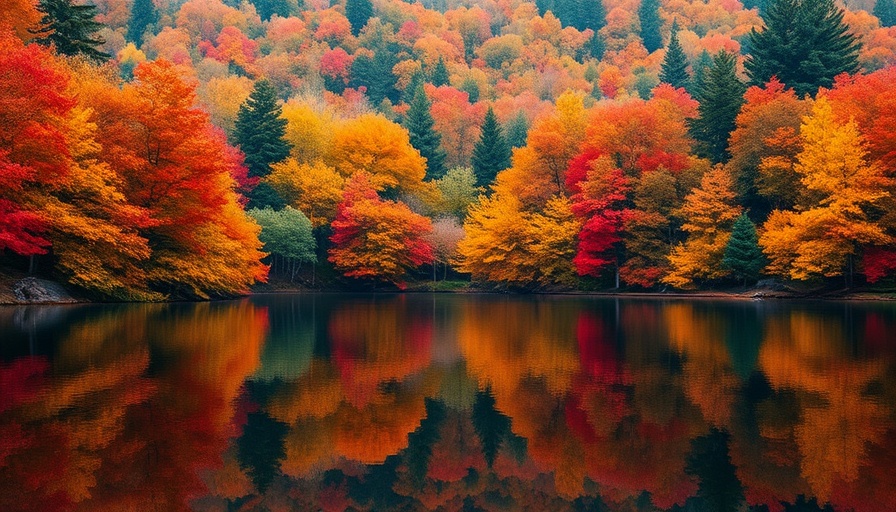
Finding Beauty in Michigan's Autumn: Top Trees and Shrubs for Fall Foliage
As the days grow shorter and the air crisper, Michigan transforms into a vibrant palette of fall colors. If you’re considering enhancing your home landscape with stunning autumn foliage, understanding which trees and shrubs thrive in this region will ensure your outdoor space dazzles during the fall season. Here’s an exploration of some of the best options that not only contribute to aesthetics but also enrich local biodiversity.
Why Choose Native Trees?
Opting for native trees and shrubs, like the Sugar Maple (Acer saccharum) and the Red Maple (Acer rubrum), offers numerous benefits. These species are not only well-adjusted to Michigan's soil and climate but also support local wildlife. Insects, birds, and small mammals find habitat and food within these native trees, promoting ecological balance. Sugar Maples, with their brilliant triad of red, orange, and yellow leaves, can grow up to 75 feet tall, offering both shade in summertime and striking autumn views. Additionally, tapping into their sap can lead to delicious maple syrup production.
Show-Stopping Shrubs: The Burning Bush
If you’re searching for dramatic color, look no further than the Burning Bush (Euonymus alatus). This adaptable shrub boasts stunning crimson hues in the fall, creating a bold visual impact in any yard. Ideal for hedge planting or as a standalone ornament, it requires little maintenance beyond some attention to soil drainage and sunlight. However, gardeners should be cautious, as this beautiful shrub can be invasive in some areas, reminding us to think critically about our plant choices and their implications on local ecosystems.
Serviceberry: A Year-Round Wonder
The Serviceberry (Amelanchier spp.) is a superb choice for those wanting seasonal interest. This multifaceted tree not only showcases delicate white flowers in spring and edible berries in summer, but also features vibrant yellow, orange, and red leaves come autumn. Perfect for smaller yards or as accent trees, Serviceberries thrive in well-drained soil, making them a versatile addition to any landscape.
The Vibrancy of Oak Trees
Iconic in Michigan, Oak trees (Quercus spp.) provide rich colors in the fall ranging from deep reds to browns. These majestic trees are not only visually appealing but also critical for supporting local wildlife. Planting oak trees could provide you with a true long-term investment in your landscape, as they can live for hundreds of years. Oaks require attention to their growing conditions, such as full sun exposure and sufficient space to thrive, but their slow growth can often be rewarded with breathtaking autumn displays.
Witch Hazel: A Unique Addition
Witch Hazel (Hamamelis virginiana) sets itself apart with its striking yellow fall color and unique spidery flowers blooming in late autumn. This shrub not only adds visual interest during the fall but also brings a golden glow to your landscape even after many trees have shed their leaves. Best for small to medium yards, Witch Hazel prefers moist, well-drained soil, benefitting from partial to full sunlight. By including this unique shrub, you can extend the beauty of your garden well into the late season.
Practical Tips for Planting
When adding any of these trees or shrubs to your landscape, consider the maintenance tips outlined for each species. Monitoring soil moisture and planting the right tree in suitable sunlight conditions can make a tremendous difference in your plants' vibrancy and health. Before planting, assess your yard’s specific environmental conditions: sunlight availability, soil type, and space to ensure maximized growth potential.
Let’s Plan for a Vibrant Future
The choices you make in planting trees and shrubs contribute to the long-term health and beauty of Michigan’s environment. Not only do they provide color, but they also offer ecological benefits by attracting and nurturing local wildlife. As we embrace sustainable landscaping practices, let’s commit to choosing plants that harmonize with Michigan’s native ecosystems.
 Add Row
Add Row  Add
Add 




 Add Row
Add Row  Add
Add 

Write A Comment